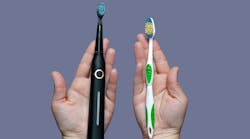Dear Patient: What's the best toothpaste?
Do you ever feel overwhelmed in the toothpaste aisle of the drugstore? There are so many options. Each has its own amazing claim! One will whiten your teeth, another will fight plaque, another is all-natural, and the one next to it will rebuild enamel. What to choose?
A conversation with your dental team is definitely the place to start. You might have specific needs that a particular toothpaste can help with. But until your appointment, here are some ingredients to consider.
Fluoride
Fluoride is the cavity-fighting ingredient in toothpaste. It can help strengthen enamel and prevent decay. Most toothpaste contains sodium fluoride; however, there is an emerging trend to use stannous fluoride. In the past, stannous fluoride has caused teeth staining. However, manufacturers have found a way to stabilize it to eliminate or decrease the staining. There is some science that shows stannous is more effective at fighting the bacteria that cause gum disease and helps with sensitivity.1
Nonfluoride options
There’s a wave of patients looking to avoid fluoride. While I’m still an advocate of toothpaste containing fluoride, there are some ingredients to look for if you are trying to avoid it. If you are looking for more benefits from your toothpaste, many companies also combine these ingredients in fluoride toothpaste.
Hydroxyapatite (HA) and nano-hydroxyapatite (NHA) toothpaste are emerging. While the science is still catching up, these might be effective at rebuilding enamel and helping with sensitivity.
Arginine is an amino acid that has the potential to control biofilm in the mouth. If used regularly, it can help keep the pH in your mouth closer to neutral, which helps fight cavities and gum disease. It also reduces sensitivity.
Xylitol is looking promising for fighting cavities and returning your mouth to a neutral pH. If you experience dry mouth, looking for products with xylitol might be just what you need. It helps to stimulate the production and increase the quality of your saliva.2
Whitening
It seems all my patients want a whitening toothpaste, and that’s probably the claim that you see the most on the tubes in your drugstore. Truthfully, if you really want to whiten your teeth, talk to your dental team. None of the whitening toothpastes will dramatically change the shade of your teeth. However, they might help remove some stains, making your teeth appear whiter.
Ingredients to avoid
Watch out for toothpaste with sodium lauryl sulfate (SLS), a foaming agent. This ingredient can be irritating for some people. If you ever notice your gums peeling, you might have a sensitivity to SLS.
Does the ADA seal matter?
While the ADA seal is reassuring to see, it’s not a dealbreaker for me to recommend a toothpaste. The ADA seal program is voluntary, meaning it takes time and money to apply. Companies can submit evidence that their product meets specific requirements for safety and efficacy. The ADA looks for toothpaste with the right amount of fluoride, fluoride release and absorption, and relative dentin abrasivity (RDA) under 250. You will not see any nonfluoride toothpaste with the ADA seal.
The most important thing about selecting the right toothpaste is to pick one you will use. I personally have about four different kinds that I rotate through to maximize the benefits of key ingredients. And after you brush for those precious two minutes, don’t rinse your mouth. Let the toothpaste keep working long after you’ve left the bathroom.
References
-
Miller S, Truong T, Heu R, Stranick M, Bouchard D, Gaffar A. Recent advances in stannous fluoride technology: antibacterial efficacy and mechanism of action towards hypersensitivity. Int Dent J. 1994;44(1 Suppl 1):83-98.
-
Sánchez-Blanco I, Rodríguez-Téllez M, Corcuera-Flores JR, et al. Effectiveness of salivary stimulation using xylitol-malic acid tablets as coadjuvant treatment in patients with gastro-oesophageal reflux disease: early findings. Med Oral Patol Oral Cir Bucal. 2020;25(6):e818-e826. doi:10.4317/medoral.23887
Amanda Hill, BSDH, RDH, CDIPC, is an enthusiastic speaker, innovative consultant, and award-winning author who brings over 25 years of clinical dental hygiene and education to dentistry. Recipient of OSAP’s Emerging Infection Control Leader award and an active participant with the advisory board for RDH magazine, DentistryIQ, and OSAP’s Infection Control in Practice Editorial Review Board and membership committee, Amanda (also known as the Waterline Warrior) strives to make topics in dentistry accurate, accessible, and fun. She can be reached at [email protected].
About the Author

Amanda Hill, BSDH, RDH, CDIPC
Amanda Hill, BSDH, RDH, CDIPC, is an enthusiastic speaker, innovative consultant, and award-winning author who brings over 25 years of clinical dental hygiene and education to dentistry. Recipient of OSAP’s Emerging Infection Control Leader award and an active participant with the advisory board for RDH magazine, DentistryIQ, and OSAP’s Infection Control in Practice Editorial Review Board and membership committee, Amanda (also known as the Waterline Warrior) strives to make topics in dentistry accurate, accessible, and fun. She can be reached at [email protected].


